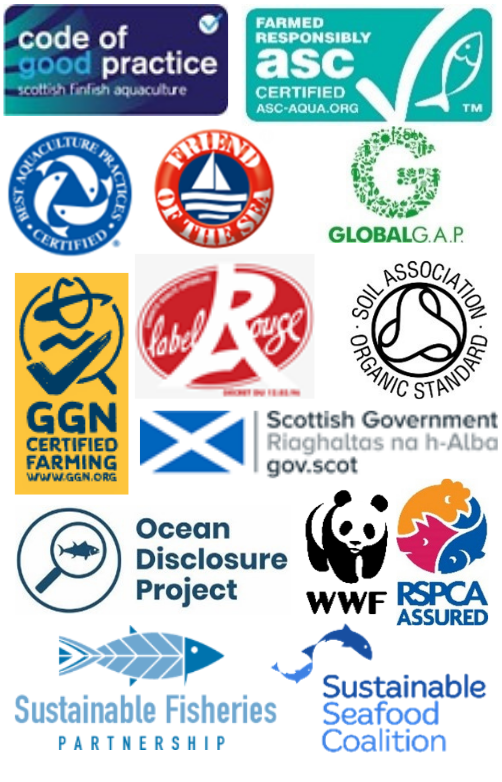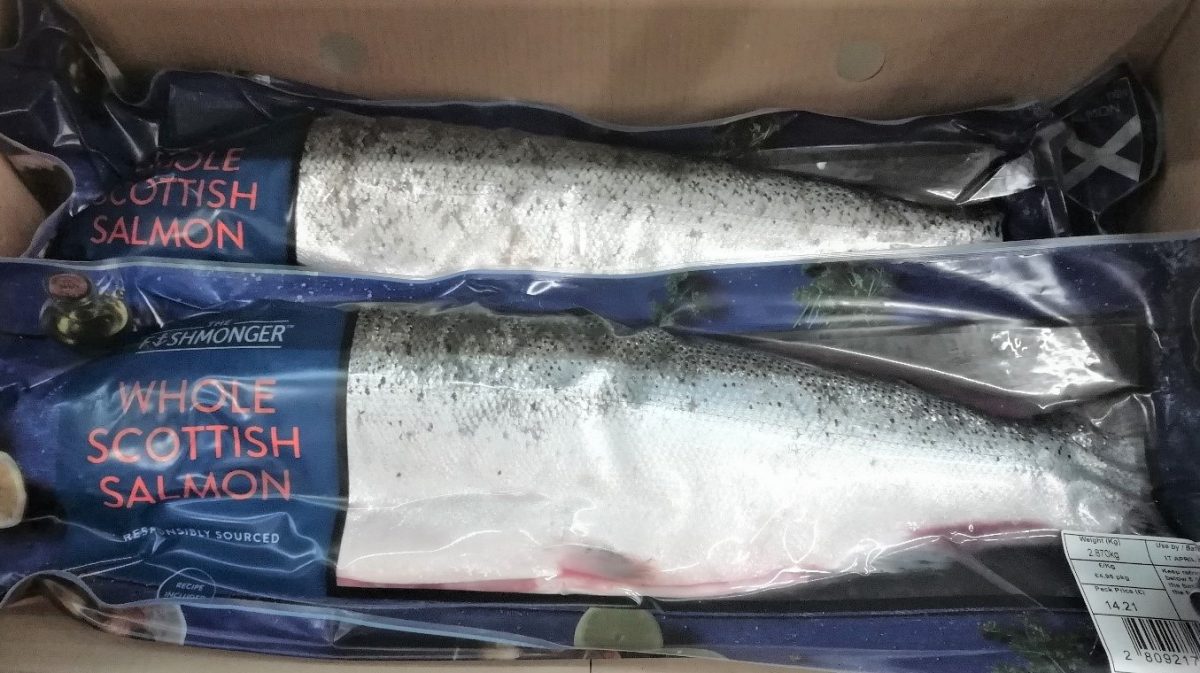Read our understanding of and position on the certification of Scottish salmon farming.
What is certification?
Many salmon products on the shelves of our supermarkets have labels declaring it is farmed ‘responsibly’ and/or ‘sustainably’, but what does this actually mean?
These labels show whether the process of farming that salmon meets a certain standard. A standard is a documented agreement with technical specifications, or precise criteria, used as a guideline or definition. Certification is the assessment of whether a product or process complies to a standard. To put it simply, certification labels aim to answer the question – “does the product meet the standards?”. If standards are met, a certificate is awarded and usually comes in the form of a label on the pack of your product.

Logos of certification schemes and other standards for salmon products
In the case of salmon farming, multiple ‘certification bodies’ exist. These aim to assess a certain level of standards on fish welfare, management and use of chemical treatments, environmental impact, and interactions with wild species. It can be confusing to know which certification schemes have the strictest requirements and therefore offer the greatest level of compliance with these criteria.
Our certification paper
Our position paper on certification aims to outline the opportunities and challenges of schemes in use by the salmon farming sector in Scotland. It reviews each scheme’s area of focus and effectiveness, and presents our position on which certification bodies appear to offer the greatest level of protection for the habitats impacted by the industry.
Download and read our certification paper here.
We conclude that the ASC scheme has the strictest requirements for environmental impact, disease, social responsibility and transparency. Regarding transparency, ASC is the only scheme which lists individual farms that are certified and posts the audit reports online which include details of other certification schemes.
Pros and cons of certification
Certification schemes are intended to improve the quality of standards. However it is important to acknowledge there is a controversial interaction between certification bodies and businesses being certified. Businesses being accredited pay the certifying body to award their performance and this can impact consumer confidence in schemes[1]. This should be considered when using certification schemes to provide greater information to consumers by retailers.
In the case of salmon producers, certification bodies need payments from companies to run as a viable business. So, it is a difficult to maintain a balance between making the standards achievable enough that the salmon producers will continue to pay for the fish to be certified, and it being too strict or too costly for them to see certification as a viable element of their supply chain.
Another issue with certification is that it is site specific. Therefore individual farms may be certified without considering the accumulative impact that several farms in one area could have on the environment[2].
Additionally, the strictness of standards varies widely between certification schemes, with some making ‘recommendations’ that don’t need to be adhered to. Even where criteria are ‘requirements’ and must be met to pass, companies can apply for a ‘variation’. This means they do not have to meet a required measure. Also,the standards do not always consider external impacts, such as the use of unsustainably produced feed, transport and processing[3].
Encouraging best practice
However, certification can encourage best practice [4] and in aquaculture it has led to improvements in waste management, risk assessments, mitigation plans and measures[5]. Additionally, complying with the audit process often requires better documentation and reporting, giving the opportunity for increased traceability and transparency. It should be noted though that the majority of schemes in our assessment still score very low for transparency of information. Independent research shows this is still the case for many schemes[1, 4].

Packaged whole Scottish salmon © Fidra
Our recommendations to increase transparency and accountability
One of Fidra’s main asks is to increase transparency within the aquaculture sector. This will in turn increase accountability and drive the adoption of best practice. We believe this can be achieved through an online database or ‘sustainability dashboard’. A well-designed dashboard would showcase what is currently being done at individual farm level in a clear and transparent way. Hosting all the data in a centralised location and accessible format will make it easy for consumers, retailers, industry, local authority planners and communities local to the fish farms to use.
In addition to increased transparency on the environmental impacts of individual salmon farms in Scotland, Fidra would also like to see best practice processes implemented that reduce impacts on the local environment and to ensure regulators adopt robust legislation and effective enforcement.
Finally, to show true accountability to the consumer, the supply chain of farmed Scottish salmon must be entirely transparent. The clearest way to do this is to label individual Scottish salmon products with the name of the farm that produced the salmon. A corresponding sustainability dashboard could then host information at a farm level on environmental performance, levels of certification and regulatory compliance. Consumers in turn are then able to make informed choices about the salmon products they purchase.
References
[1] Eden, S., Bear, C. & Walker, G., 2008. Understanding and (dis) trusting food assurance schemes: consumer confidence and the ‘knowledge fix’. Journal of Rural Studies, 24(1), pp.1-14. https://doi.org/10.1016/j.jrurstud.2007.06.001
[2] Osmundsen, T.C. et al (2020) The operationalisation of sustainability: Sustainable aquaculture production as defined by certification schemes. Global Environmental Change, 60, 102025. https://doi.org/10.1016/j.gloenvcha.2019.102025
[3] Amundsen, V.S., Gauteplass, A.A. & Bailery, J.L. (2019) Level up or game over: the implication of levels of impact in certification schemes for salmon aquaculture. Aquaculture Economics & Management, 23:3, 237-253. https://doi.org/10.1080/13657305.2019.1632389
[4] Steering Committee of the State-of-Knowledge Assessment of Standards and Certification. (2012). Toward sustainability: The roles and limitations of certification. Washington, DC: RESOLVE, Inc., 427pp
[5] Vince, J. & Haward, M. (2019) Hybrid governance in aquaculture: Certification schemes and third party accreditation. Aquaculture, 507, 322-328. https://doi.org/10.1016/j.aquaculture.2019.04.041
Tags: ASC, certification, GAA BAP, Global GAP, Label Rouge, Organic, RSPCA Assured, Scottish salmon farming

